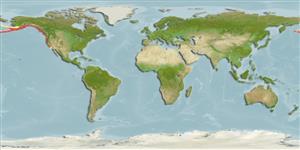Teleostei (teleosts) >
Pleuronectiformes (Flatfishes) >
Pleuronectidae (Righteye flounders) > Hippoglossinae
Etymology: Eopsetta: Greek, eos = dawn, aurore + Greek, psetta = grouper (Ref. 45335); jordani: Named after David Starr Jordan, great inciter of ichthyology in the USA (Ref. 6885).
Eponymy: Dr David Starr Jordan (1851–1931) was a leading American ichthyologist, physician, educator, peace activist and believer in eugenics; moreover, he was founding President of Stanford University. [...] (Ref. 128868), visit book page.
Environment: milieu / climate zone / depth range / distribution range
Ecology
Marine; demersal; depth range 0 - 550 m (Ref. 6793). Temperate; 67°N - 31°N, 172°E - 117°W
Northeastern Pacific: Bering Sea coast of Alaska to Islas Los Coronados, northern Baja California, Mexico.
Length at first maturity / Size / Weight / Age
Maturity: Lm 43.0, range 40 - 44 cm
Max length : 53.0 cm TL male/unsexed; (Ref. 56527); 70.0 cm TL (female); common length : 42.5 cm TL male/unsexed; (Ref. 56527); max. published weight: 3.7 kg (Ref. 56527); max. reported age: 35 years (Ref. 55701)
Short description
Identification keys | Morphology | Morphometrics
Adults are found on sand bottom (Ref. 2850), usually in deep water (Ref. 9988). Feed on invertebrates and bottom fishes (Ref. 6885). Livers of large individuals are a rich source of vitamin A (Ref. 6885). Marketed fresh or as frozen fillets (Ref. 2850). Eaten steamed, fried, micro-waved and baked (Ref. 9988). Generally regarded as the premium Pacific coast sole (Ref. 9988).
Vinnikov, K.A., R.C. Thomson and T.A. Munroe, 2018. Revised classification of the righteye flounders (Teleostei: Pleuronectidae) based on multilocus phylogeny with complete taxon sampling. Molecular phylogenetics and evolution, 125:147-162. (Ref. 122998)
IUCN Red List Status (Ref. 130435: Version 2025-1)
Threat to humans
Harmless
Human uses
Fisheries: commercial; gamefish: yes
Tools
Special reports
Download XML
Internet sources
Estimates based on models
Preferred temperature (Ref.
123201): 1 - 8.6, mean 5 °C (based on 420 cells).
Phylogenetic diversity index (Ref.
82804): PD
50 = 0.7500 [Uniqueness, from 0.5 = low to 2.0 = high].
Bayesian length-weight: a=0.00741 (0.00426 - 0.01291), b=3.08 (2.92 - 3.24), in cm total length, based on LWR estimates for this species & (Sub)family-body (Ref.
93245).
Trophic level (Ref.
69278): 4.1 ±0.67 se; based on food items.
Resilience (Ref.
120179): Very Low, minimum population doubling time more than 14 years (K=0.16; tm=6-8; tmax=35; Fec=400,000).
Prior r = 0.41, 95% CL = 0.27 - 0.61, Based on 2 full stock assessments.
Fishing Vulnerability (Ref.
59153): High vulnerability (62 of 100).
🛈
Climate Vulnerability (Ref.
125649): Moderate to high vulnerability (52 of 100).
🛈
Nutrients (Ref.
124155): Calcium = 30.7 [12.2, 52.1] mg/100g; Iron = 0.276 [0.140, 0.534] mg/100g; Protein = 17 [16, 18] %; Omega3 = 0.378 [0.181, 0.780] g/100g; Selenium = 19.1 [9.5, 42.3] μg/100g; VitaminA = 14.9 [3.5, 66.2] μg/100g; Zinc = 0.349 [0.232, 0.525] mg/100g (wet weight);
